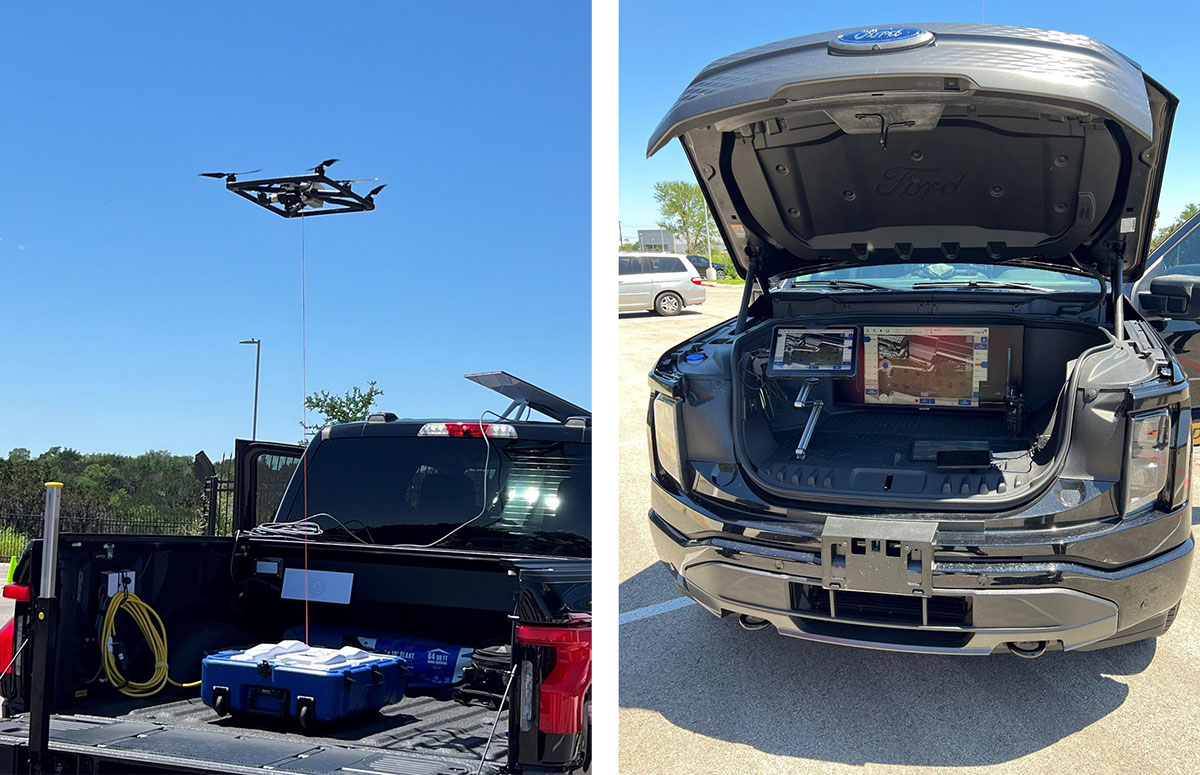August 08, 2024
Innovation of the Month: Next-Generation Traffic Incident Management (TIM)
Drones provide a bird’s-eye view of roadway incidents, increasing situational awareness for responders, helping map crash scenes, monitoring queues, and sharing images far from the scene. Tethered drones offer the advantage of being able to hover in a stable position for many hours, receiving power from a source on the ground below. A typical unmanned aerial vehicle can only fly for about 20-30 minutes.
To take advantage of the endurance of tethered drones, the Texas Department of Public Safety (DPS) recently deployed a new platform for unmanned aerial systems (UAS) that expedites delivery of the drone along with all supporting features. A newly purchased electric pickup truck is now dedicated to the DPS UAS mission. This is no ordinary pickup. The unique vehicle is set up to totally support both tethered and free-flying UAS. The tethered UAS deploys from a roll-open truck bed, and it is powered by the truck’s 9.6 kW power bank, enough power to fly for several days. This is an important feature since powering a tethered drone typically involves using vehicle power inverters or generators. A satellite communication system is built into the truck, ensuring that communication is present in even the most remote locations.

Once hovering, the tethered drone can live stream video to responders below, or anywhere in the world through the web. A convenient QR code facilitates sharing the video feed, which can also be password protected. The unique front trunk or “frunk” of the vehicle is a convenient storage area where the internal combustion engine would normally be located. Once opened, two large monitors allow people on the ground to view everything in the view of the drone’s camera. The Texas DPS envisions many uses for the new vehicle like capital security, homeland security, planned special events, and, of course, major traffic incidents when the vehicle is within proximity.
The ability to monitor traffic queues at crashes and share video with DPS management and the Texas Department of Transportation (TxDOT) Traffic Management Center (TMC) are excellent examples of how the new UAS vehicle may be a game-changer for traffic incident management (TIM). It is also an excellent example of Next-Generation TIM technology that is part of the EDC-7 innovation.
To learn more about Next Generation TIM Tech and technologies that your agency can use to protect motorists and responders after a traffic incident, please contact Joe Tebo, James Austrich, or Paul Jodoin, FHWA Office of Operations.
ODOT’s Leap into the Digital Future
In an era defined by technological innovation, the Oklahoma Department of Transportation (ODOT) is embracing the challenge of establishing a more efficient and digitally-driven project lifecycle.
The ODOT Digital Delivery program started as a pilot cross-functional design team in January 2022, and quickly evolved into a permanent, dedicated digital delivery team as the advantages of data enhanced 3D models became apparent.
A key benefit of Digital Delivery is the ability to enhance collaboration and communication among project stakeholders. ODOT started training design engineers and technicians in modeling tools to help engineers optimize resource allocation and improve cost-effectiveness. By simulating various design scenarios in 3D models, ODOT can identify potential risks and opportunities early in the project lifecycle, minimizing costly rework and delays down the line. ODOT is revolutionizing the way projects are planned, designed and executed in Oklahoma with Digital Delivery, paving the way for a smarter and more interconnected Department of Transportation.
ODOT was awarded an Advancing Digital Construction Management Systems (ADCMS) grant in November 2023. The grant is a comprehensive program to accelerate the adoption of BIM for Infrastructure in Oklahoma. Program areas include design implementation; construction and inspection implementation; work force development and K-college STEM outreach.
Looking ahead, ODOT remains committed to pushing the boundaries of innovation and embracing technologies to further advance its Digital Delivery capabilities. ODOT participates in the BIM for Bridges and the BIM for Infrastructure Transportation Pooled Funds and continues to seek ways to engage with the larger engineering community on digital delivery topics.
If you would like to learn more about ODOT’s Digital Project Delivery you may contact Katie Brown, ODOT Transportation Quality Digital Delivery Engineer or Michael Pearson, ODOT Digital Delivery Manager. If you would like to learn more about FHWA efforts regarding Digital Project Delivery you may contact Bryan Cawley FHWA Highway Engineer.
Stay Up to Date on the EDC Innovations That Interest You Most

EDC teams are always on the move! If you blink, you could miss out on important webinars, case studies, tools, videos, and more. To never miss information for the EDC innovations that interest you most, visit the subscription page and select the topics you’d like to receive updates on directly from the teams that coordinate them.
Recent bulletins:
Next-Gen TIM 7/31/24
SWD 7/31/24
Upcoming Events
Innovation Practices from the Local Technical Assistance Program (LTAP)
Centers
August 15, 2024, 2:00-3:00 pm ET Register
State DOTs Building Workforce Partnerships
August 15, 2024, 1:00-2:30 pm ET Register
Roadway Safety for People Experiencing Homelessness
September 4, 2024, 1:00-3:00 ET Register
About EDC
Every Day Counts, a State-based initiative of the Federal Highway Administration's Office of Innovation and Workforce Solutions, works with State, local, and privatesector partners to encourage the adoption of proven and underutilized technologies to deliver transportation projects more efficiently, enhance safety forall users, support a sustainable and resilient infrastructure, and incorporate equity inproject planning and delivery.
EDC News is a weekly publication highlighting successful EDC innovationdeployments across the country.
Disclaimer: The U.S. Government does not endorse products or manufacturers. Trademarks or manufacturers’ names appear in this document only because they are considered essential to the objective of the document. They are included for informational purposes only and are not intended to reflect a preference, approval, or endorsement of any one product or entity.
Except for the statutes and regulations cited, the contents of this document do not have the force and effect of law and are not meant to bind the States or the public in any way. This document is intended only to provide information regarding existing requirements under the law or agency policies.
Recommended Citation:
U.S Department of Transportation, Federal Highway Administration
EDC News; August 8, 2024
Washington, DC


